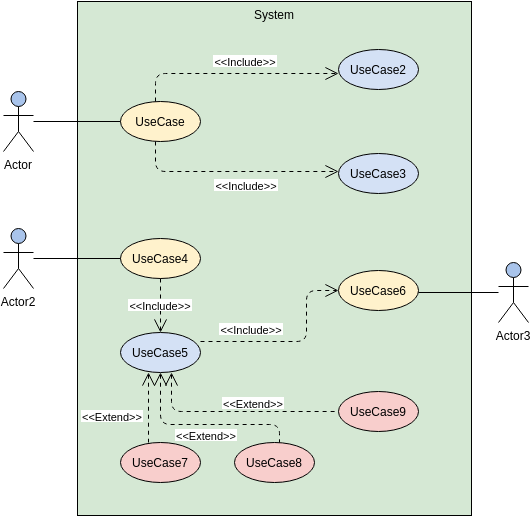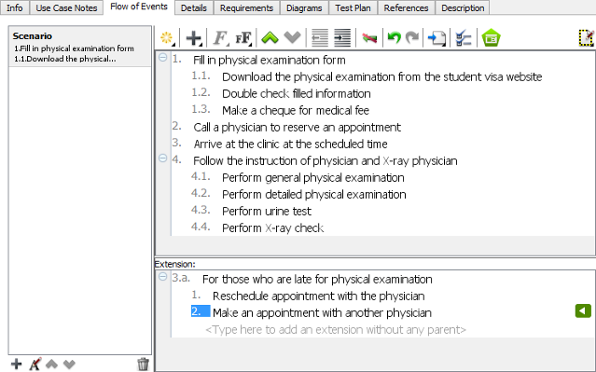Demystifying Use Cases, Scenarios, Flow of Events, and Templates
Introduction
In the realm of software development and systems analysis, creating a clear and comprehensive blueprint is essential. Use cases, use case scenarios, flow of events, and use case templates are integral components in this process. Let’s delve into each of these elements to understand their relationships and how they contribute to building robust systems.

Understanding Use Cases
A use case is a high-level description of a system’s functionality from an external perspective. It defines the interactions between an external actor (a user or another system) and the system itself. Use cases serve as a foundation for understanding system behavior and are instrumental in capturing functional requirements.

Use Case Scenarios
Use case scenarios provide a detailed narrative of how a particular use case unfolds. These scenarios outline the sequence of interactions between the external actor and the system, depicting the various steps and conditions that may arise during execution. They offer a more granular view, helping developers and stakeholders visualize the specific user interactions.
The Flow of Events
The flow of events is a crucial aspect of use case scenarios. It outlines the step-by-step progression of actions within a use case. Each step in the flow of events corresponds to a specific action or decision point, offering a comprehensive view of the user-system interaction. Identifying alternate flows and exceptions is vital for anticipating different paths a use case may take.
Use Case Templates
Use case templates provide a standardized structure for documenting use cases. They typically include sections for the use case name, description, actors, preconditions, postconditions, and the main and alternative flows. Templates offer a systematic way to capture and organize information, ensuring consistency across various use cases within a project.
Relationships
-
Use Case and Use Case Scenario:
- A use case encapsulates multiple scenarios. It represents the overarching functionality.
- Scenarios provide a detailed breakdown of specific instances or paths within a use case.
-
Use Case Scenario and Flow of Events:
- Scenarios are composed of the flow of events.
- The flow of events outlines the chronological sequence of actions and decision points within a scenario.
-
Use Case and Use Case Template:
- A use case is a conceptual description of system functionality.
- The use case template provides a structured format for documenting the details of a use case.
Example
Let’s use a simple example to illustrate the relationships among use cases, use case scenarios, flow of events, and use case templates.
Example: Online Shopping System
-
Use Case:
- Title: Place Order
- Description: The user initiates the process of purchasing items online.
-
Use Case Scenario:
- Scenario: User adds items to the cart and proceeds to checkout.
-
Flow of Events:
- User logs in.
- User browses products and adds items to the cart.
- User goes to the checkout page.
- System prompts user to confirm the order.
- User confirms and submits the order.
-
Use Case Template:
- Use Case Name: Place Order
- Description: Initiates the process of purchasing items online.
- Actors: Registered User
- Preconditions: User is logged in.
- Postconditions: Order is placed successfully.
-
Main Flow:
- User logs in.
- User adds items to the cart.
- User goes to the checkout page.
- System prompts user to confirm the order.
- User confirms and submits the order.
- Alternate Flow: None in this case.
In this example:
- The use case is the high-level description of the functionality: placing an order.
- The use case scenario breaks down a specific instance of placing an order, detailing the steps from logging in to confirming the order.
- The flow of events provides a step-by-step sequence for the scenario, specifying the actions and decision points.
- The use case template offers a standardized format for documenting the use case, ensuring consistency across various use cases in the system.
This breakdown helps in understanding the hierarchical structure and relationships among these elements in the context of a real-world scenario like online shopping.
Illustrate the Relationships
Let’s compare the differences among use cases, use case scenarios, flow of events, and use case templates using a table for a clear contrast:
| Aspect | Use Case | Use Case Scenario | Flow of Events | Use Case Template |
|---|---|---|---|---|
| Purpose | Describes overall system function | Provides a detailed instance of use case | Breaks down the steps within a scenario | Documents details of a use case |
| Scope | High-level | Specific instance within a use case | Granular view of actions | Standardized structure for documentation |
| Content | Broad functionality | Detailed narrative of user interaction | Chronological sequence of actions | Sections for name, description, actors, preconditions, postconditions, main flow, alternate flow |
| Focus | Conceptual | Specific user interactions | Detailed steps and decision points | Structured representation of use case details |
| Level of Detail | General | More specific | Detailed and sequential | Standardized but detailed |
| Representation | Conceptual model | Narrative text | Sequential steps | Structured document format |
| Usefulness | Provides an overview for stakeholders | Helps visualize specific user interactions | Aids in understanding detailed steps | Ensures consistency in documentation |
This table highlights the key differences among use cases, use case scenarios, flow of events, and use case templates in various aspects such as purpose, scope, content, focus, level of detail, representation, and usefulness. Each element plays a unique role in the process of system development, contributing to a comprehensive understanding and effective communication among stakeholders.
Conclusion
In essence, use cases, use case scenarios, flow of events, and use case templates are interconnected elements in the process of system development. Use cases offer a holistic view, scenarios provide detailed narratives, flow of events breaks down the steps, and templates provide a standardized documentation format. A cohesive understanding of these components ensures that development teams and stakeholders are on the same page, leading to the creation of effective and user-friendly systems.
the relationships among use cases, use case scenarios, flow of events, and use case templates form a crucial framework in the world of software development and system analysis.
- Use Cases: These provide a high-level description of a system’s functionality from an external perspective, acting as a conceptual model for understanding system behavior.
- Use Case Scenarios: These offer a detailed narrative of how a specific use case unfolds, breaking down the overarching functionality into specific instances.
- Flow of Events: This represents the chronological sequence of actions within a use case scenario, outlining the steps and decision points that occur during execution.
- Use Case Templates: These provide a standardized structure for documenting use cases, ensuring consistency in capturing essential details like actors, preconditions, postconditions, and the main and alternate flows.
In an example involving an online shopping system, we explored how these elements interconnect. The use case serves as a broad overview, scenarios provide specific instances, flow of events details the steps, and templates offer a structured format for documentation.
Understanding these elements’ relationships is essential for effective communication among development teams and stakeholders, ensuring a clear and comprehensive blueprint for building robust systems. Together, they contribute to the clarity, consistency, and success of the software development process.
Use Case Examples and Templates


